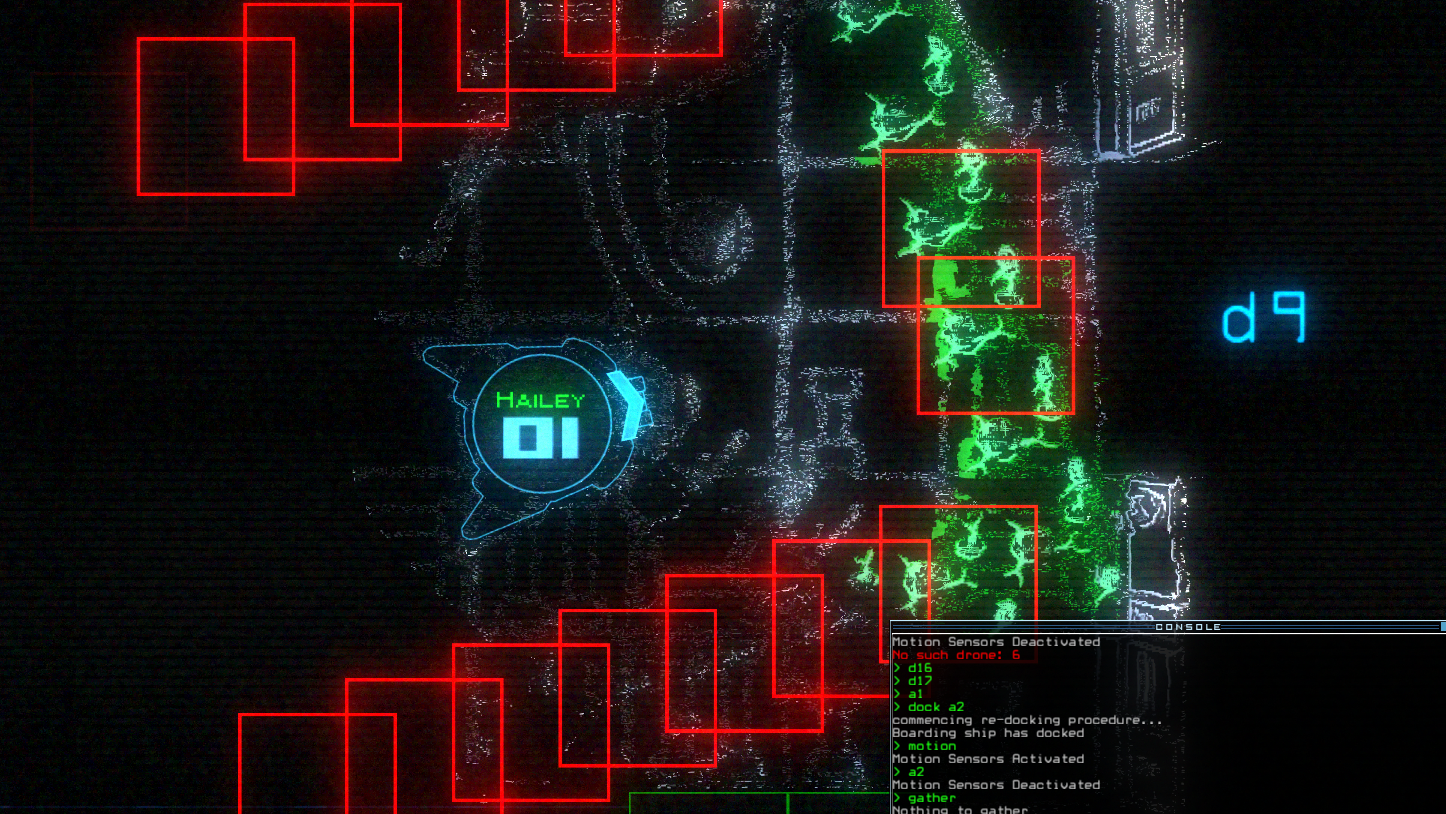Our Verdict
A tense and spooky strategy roguelike that's as satisfying as it is harrowing.
PC Gamer's got your back
What is it? A tense strategy game where you explore spooky spaceships using drones.
Expect to pay: $20/£15
Developer: Misfits Attic
Publisher: Misfits Attic
Reviewed on: Intel i7 x980 3.33 GHz, 9 GB RAM, Nvidia GeForce GTX 980
Multiplayer: No
Link: Official Site
Something is chewing through a door on the derelict space station Volgograd. I’ve been exploring the station room-by-room, for long minutes, with my fleet of drones, and so far it’s been a safe and worthwhile excursion. Now, though, I feel like I’ve overstayed my welcome. I quickly command my scouting drone to return to my docked dropship, but just as it speeds past the door that is being chewed through, I hear a loud beeping. My console informs me that my second drone, which is powering a generator, is being damaged by another something that has crept through an open air vent and spread across the room.
I quickly drive my second drone away from the new biological alien threat, which disconnects the power supply, which means I can no longer remotely open and close doors in the station. My scouting drone is now trapped in the room it’s in, the one with the door that is about to give way to that something. My third drone, at least, can manually pry open doors, but before I can dispatch it to save my first drone, I’m informed an asteroid shower is imminent. This leisurely and lucrative mission has, in the blink of an eye, become a panicky race against time.
This is the best part of Duskers, a survival strategy roguelike in which you pilot drones through procedurally generated derelict spaceships. It’s perfectly fun and satisfying when things are going your way, but when the shit hits the airlock, when your careful plans fall apart and you’re forced to think quickly, when a successful mission becomes a harrowing, scrambling nightmare, Duskers really shines.

Dead space
You begin with only a few days of fuel for your spaceship, three drones, and the news that an undefined catastrophe has resulted in a post-apocalyptic universe in which you may be the only human survivor. You dock with other ships and send in your drones to explore, scavenging for spare fuel, scrap metal, bits of information from corrupted ship’s logs, and even other drones you can repair and add to your fleet (or turn into scrap). You steer your drones one at a time using the arrow keys, and there’s also a console to enter commands into: ‘navigate 1 3 r4’, for instance, will auto-pilot drones 1 and 3 into room 4. Drones have slots for three modules, which give them different abilities. The gather module will allow a drone to harvest scrap and fuel, the generator module can supply power to doors, and so on. There are droppable lures and traps, motion sensors and scanning beacons, shields and mounted turrets, and a tow module for dragging disabled drones or upgrades back to your dropship. You can swap modules between drones before a mission, or even during one provided the drones are adjacent to one another.
Naturally, you’re not alone. Enemies lurk unseen aboard the ships you visit. They might be automated ship defenses, a slowly creeping biological infestation, swarms of tiny robots, or a horrifyingly fast-moving alien entity that will pounce on and disable your drones in a split second. Sometimes, they’ll be all of the above: you never really know what you’re up against until you’re in the same room with it, at which point it’s often too late. Ship airlocks and doors can be opened and closed using simple console commands, provided they are powered by a generator. It’s a series of tense and spooky strategic challenges: keeping walls and closed doors between your drones and the enemies you’ve detected, herding or luring the dangerous entities around the ship, even trapping them in a room with an airlock and then opening it to suck them into space (along with whatever else is in the room).

Generations
The sound design of Duskers is—forgive the pun—stellar. The creaks and groans of the ship’s hull, the distant clanking and clunking that might simply be machinery or something far worse, the distinctive whirs and beeps of your various drones, and especially the muted, immensely satisfying thunder of sentry guns firing on alien life forms in another part of the ship after you’ve hacked and enabled defenses. With only the grid-like map view of the ships and the grainy, flickering footage of whatever is within the vicinity of your drones, Duskers has an eerie and unsettling lo-fi look to it, but it truly comes alive in your headphones.
Duskers unfortunately suffers from the same problem many roguelikes do: your starting roll can often predetermine how much fun a particular session ultimately is. Sometimes you’re saddled with drone modules you don’t like, or the early ships you visit are too big or too dangerous for you to adequately handle, or the trading depots don’t have the items you need or want. As a result, the occasional game can be a slow and disappointing slog with little chance of improvement or enjoyment. For several games in a row I passed a dozen ship interfaces that I didn’t have the correct module to access. Other times I had the module from the beginning but never found a terminal to use it on. And, once in awhile I’ve simply been unable to find enough fuel to continue, and my promising game just disappointingly petered out. I get it: them’s the breaks in a randomized universe, but it can still rankle at times.

This doesn’t stop Duskers from being a great game: challenging, always tense, and completely startling at times. Entering a new ship always makes me nervous. Opening my first door, no matter how careful I’ve been, always makes me brace myself for what horrors may lie ahead. Frantically typing commands into the console when things suddenly go sideways my makes me feel like I’m really huddled in a darkened dropship, alone, desperately trying to save my drones and by extension myself. Successfully detecting, evading, herding, and trapping malignant entities is satisfying every single time.
Especially when I can suck one of those door-chewers out of an airlock and into cold space. Chew on that.

Drop a lure in Room 10, open the far doors, and see if something bites. Something usually does.

Snippets from the ships' logs will help you piece together what may have happened.

Some stations are built in the middle of asteroids, meaning you'll need to buy or find a transporter to reach them.

Clear a ship of infestations, and you can commandeer it if it's better than your own.

I sent Jeff to rescue Jeremy. Now I need to send someone else to rescue Jeff.

Powered doors are green. To open the rest, I'll need to find another generator, or pry them open.

Of course, the room with all the goodies also gets a red hit from the motion detector. Of course.
A tense and spooky strategy roguelike that's as satisfying as it is harrowing.

Chris started playing PC games in the 1980s, started writing about them in the early 2000s, and (finally) started getting paid to write about them in the late 2000s. Following a few years as a regular freelancer, PC Gamer hired him in 2014, probably so he'd stop emailing them asking for more work. Chris has a love-hate relationship with survival games and an unhealthy fascination with the inner lives of NPCs. He's also a fan of offbeat simulation games, mods, and ignoring storylines in RPGs so he can make up his own.


